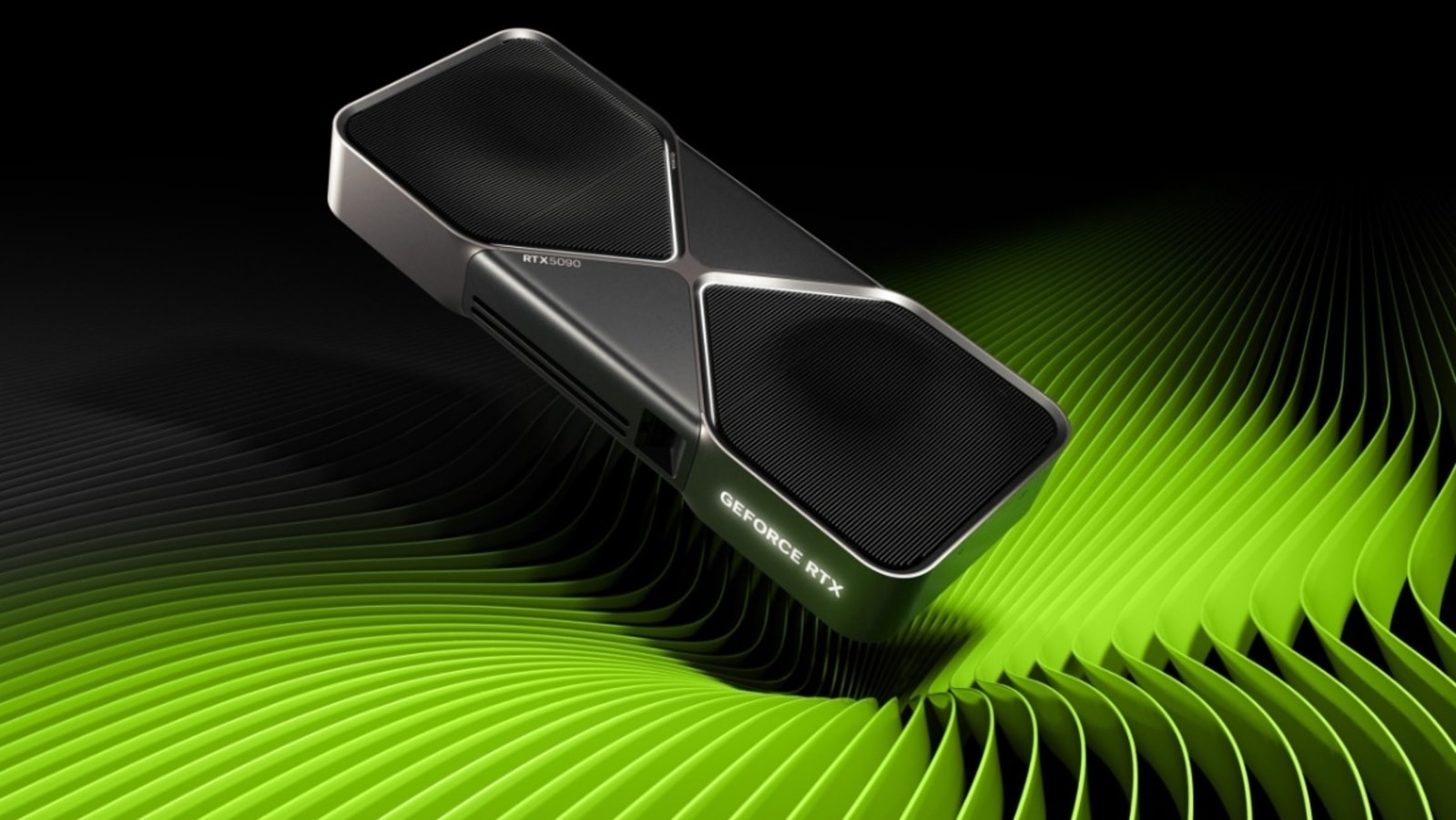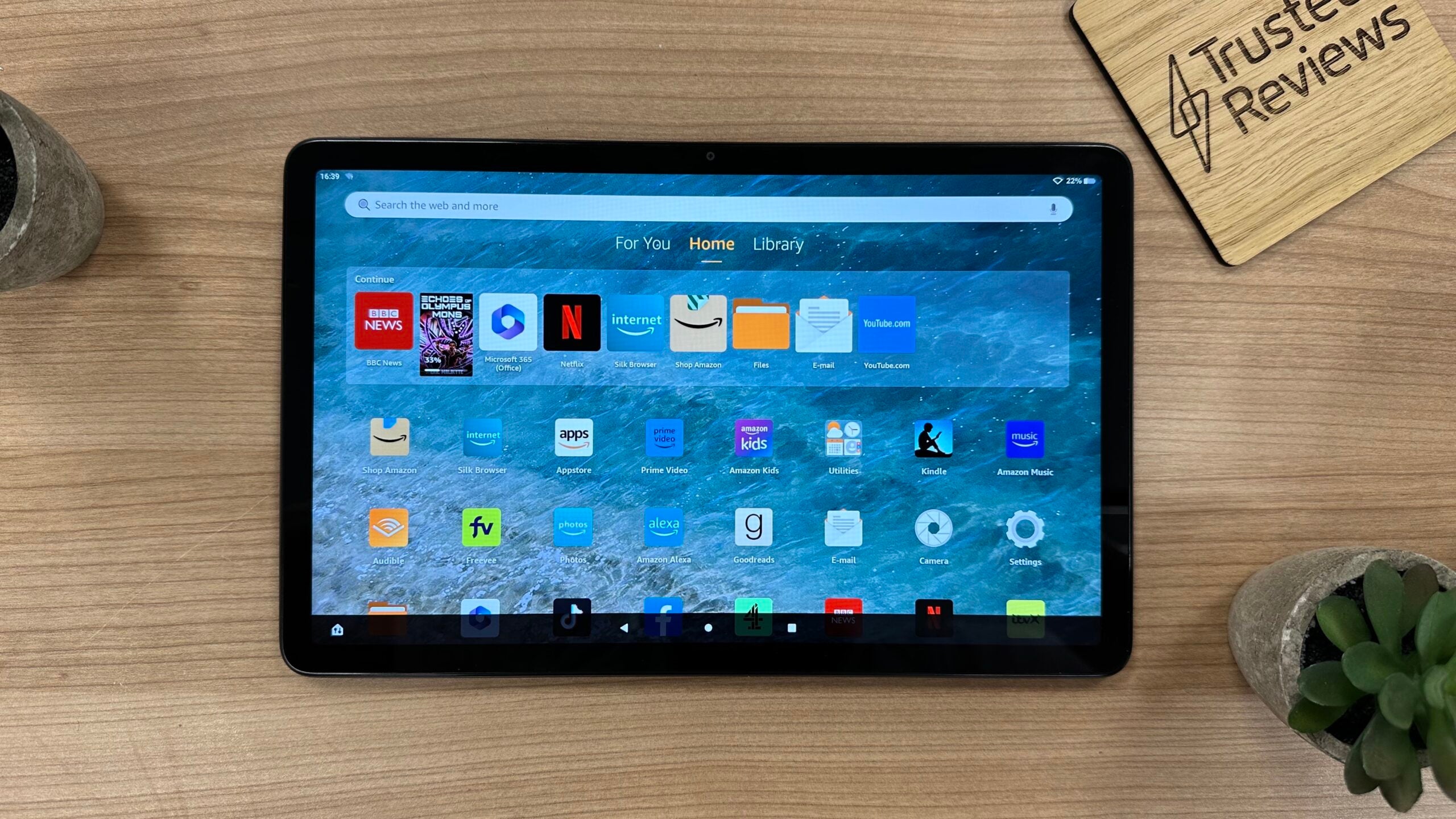Verdict
The Amazon Fire Max 11 is a capable option with a solid display that beats most of the budget competition in benchmarks, but limited app availability means it’ll never be the productivity-focused tablet that Amazon envisions.
Pros
- Much more premium design than other Fire tablets
- Great all-day battery life
- Solid 11-inch 2K display
Cons
- Limited app availability
- Very slow to charge
-
Optional work-focused accessoriesDepsite not having the best selection of productivity-focused apps, the optional keyboard and stylus are great for word processing and doodling. -
Large display ideal for streamingThe 11-inch display of the Fire Max 11 is perfect for binging series’ on Netflix and iPlayer, with loud room-filling stereo speakers to boot. -
Smooth budget performanceDespite its budget focus, the Fire Max 11 can handle basic everyday tasks and even beats most of the budget competition in benchmark tests.
Introduction
The Amazon Fire Max 11 is the latest top-end Fire tablet from Amazon, boasting a bigger display, better performance and longer battery life than the Fire HD 10 Plus. It’s certainly a change from the cheap-as-chips Fire tablets Amazon usually makes, but can Amazon compete at the higher price point?
After all, the £249/$229 Amazon Fire Max 11 runs the same Fire OS as the rest of the Fire tablet collection – software based on Android 11, but utterly devoid of any Google apps or Google services, running Amazon equivalents instead. The App Store is pretty stocked with streaming apps, but it doesn’t have everything that you’d find on a regular Android tablet.
That makes Amazon’s pitch for the Fire Max 11 as a productivity device a hard one to swallow, even with a pretty capable keyboard and stylus accessories available at additional cost.
However, if you can get along with the app offering and Amazon branding, the Fire Max 11 is a solid budget tablet with performance besting most of the cheap competition, a solid 11-inch display, an aluminium frame and 14 hours of battery life.
Design and build
- A different look to other Fire tablets
- Looks a lot like an iPad
- Only available in grey
In a bid to separate itself from the cheaper tablets in Amazon’s Fire collection, the Amazon Fire Max 11 looks decidedly more premium. In fact, rather than looking like a Fire tablet, it looks more like one of Apple’s recent iPads – more specifically, the 10th-gen iPad.

Its aluminium body is squared off with flat edges, just like Apple’s option, but it doesn’t stop there. The bezels are also of a similar size to the iPad 10, the camera is embedded in the long side of the tablet for better landscape use and even the rear camera protrudes from the shell in the same way that Apple’s does.
There’s also a handful of pro-level accessories (I’ll get to those in a minute) and even a fingerprint scanner built into the power button.
That’s not necessarily bad considering Amazon’s tablet is cheaper than the £499/$449 iPad 10, but it’s not exactly an original look. It’s a bit of a shame that it’s only available in the rather ‘professional’ grey finish, too – I think a splash of colour could’ve helped it stand out from a sea of other budget grey tablets available on Amazon’s storefront.
It does differ from Apple’s iPad in a handful of ways, though. While storage caps out at 64 or 128GB, you have a microSD card slot to extend storage when required. There’s also the odd placement of buttons, with the volume and power buttons appearing alongside the USB-C port and microSD slot on the short right-hand side of the tablet (when viewed horizontally, that is).
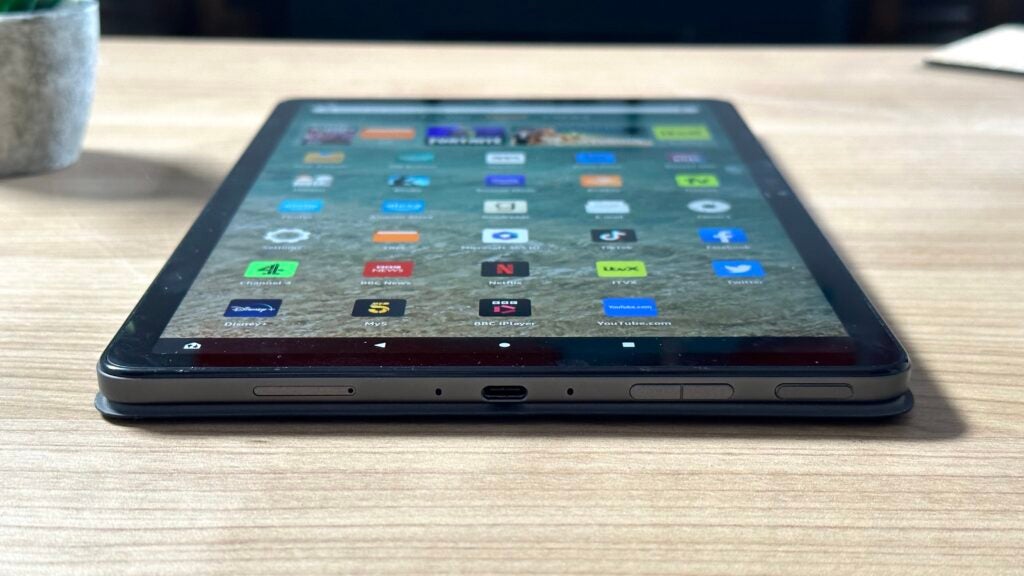
It’s a placement that took quite a while to get used to, and rather annoyingly, it became awkward to hold when charging. I was either trying to avoid knocking the USB-C cable or accidentally hitting the power or volume keys.
There’s also a slightly less elegant POGO system for connecting accessories, with the exposed ports on the bottom edge of the tablet and gaps for accessories to snap into place. It’s not exactly the slickest approach, but you probably won’t notice it often.

Elsewhere, Amazon claims that the Fire Max 11 and its strengthened glass is three times more durable than the iPad 10 in its own drop tests. That’s not something I’m easily able to test, but it should bring peace of mind to those with clumsy kids nearby.
There’s no official IP rating, however, so probably best to keep it away from kitchen countertops and bathrooms.
Display
- Large 11-inch display
- 2000 x 1200 resolution
- Not quite bright enough for use outdoors
One of the main reasons to opt for the Amazon Fire Max 11 is the display. The 11-inch IPS LCD display may not boast the deep blacks and vivid colours of OLED panels, but that’s not something you’ll find at the price point. What is important is that with a 2K (2000 x 1200) resolution, the screen is pin-sharp and packed with detail.
It also offers excellent contrast with a wide viewing angle, making it possible for me and my partner to huddle together on the sofa and enjoy a movie without fiddling with the angle.
It also exceeds the iPad 10’s display in one key area; lamination. The Fire Max 11’s display is fully laminated, and while that might not sound like much, it means there’s no air gap between the front glass and the LCD panel beneath.
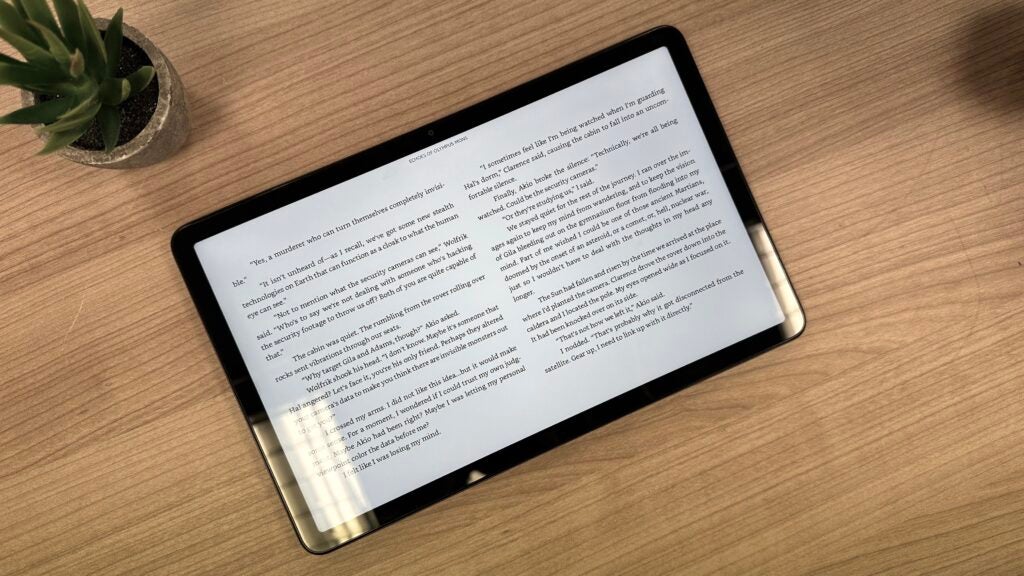
That means that, unlike the iPad, there isn’t a cheap hollow sound when you tap on the display. It feels robust, well-built and as noted earlier, it’s covered in an unnamed protective glass that should protect it from a drop or two.
If there’s any area where the Fire Max 11 could improve, it’d be brightness. Amazon’s claimed 420nits brightness is acceptable for indoor use, but it leaves much to be desired if you wander out to the garden on a particularly sunny day. It’s still just about usable, but you’ll likely be hunting for shaded areas.
The relatively low brightness means there’s no HDR support on offer either, though as with OLED tech, that’s something you’ll be hard-pressed to find at the £250/$250 price point.
Accessories
- Keyboard case is surprisingly capable
- Trackpad gestures come in handy
- Stylus is compatible with other tablets
As hinted at, the Amazon Fire Max 11 isn’t just another Fire tablet; it’s designed for work. Well, according to Amazon anyway – but I’ll get into the specifics a little later. In order to aid this lofty aim, the Fire Max 11 is compatible with work-focused accessories including a full keyboard case, complete with trackpad, and a stylus too.
The keyboard is actually pretty solid in everyday use with little key travel needed to activate each key, so much so that I actually wrote a large portion of this review on the tablet itself.

There’s a handy row of shortcut keys at the top like you’d find with a ‘proper’ laptop, and habitual Windows keyboard shortcuts also work, with the likes of Alt-Tab switching windows, CTRL + C copying text and more. The only downside is that it’s not backlit, which can be a bit of a downer when hammering away some text in a dark room.
The trackpad is also fine for everyday use, with gesture support allowing you to scroll with two fingers, pinch to zoom with two fingers and a three-finger swipe to switch apps. The only real oddity is the requirement to tap with two fingers to select text, which I couldn’t get used to during testing.

The optional stylus works in the way you’d expect, with pressure sensitivity and excellent palm rejection when taking notes on the Max’s 11-inch display, and it snaps into place on the side of the tablet when not in use just like an iPad. It’s also USI 2.0 supported, which means you can use it with other tablets like the Google Pixel Tablet, which doesn’t have an official stylus accessory.
It’s a handy optional extra for doodling and handwriting; it’s just a bit of a pain that it uses a standard AAAA battery that’ll need replacing every now and again.
Performance
- Unnamed octa-core processor
- 4GB of RAM
- Surprisingly decent budget performance
The Amazon Fire Max 11 continues the trend of Amazon using unnamed processors in its tablet range, claiming only that it’s an octa-core processor, and that’s paired with a measly 4GB of RAM and either 64 or 128GB of expandable storage depending on the variant you opt for.
Despite the rather underwhelming spec sheet, everyday performance on the Fire Max 11 is surprisingly solid for a budget tablet.
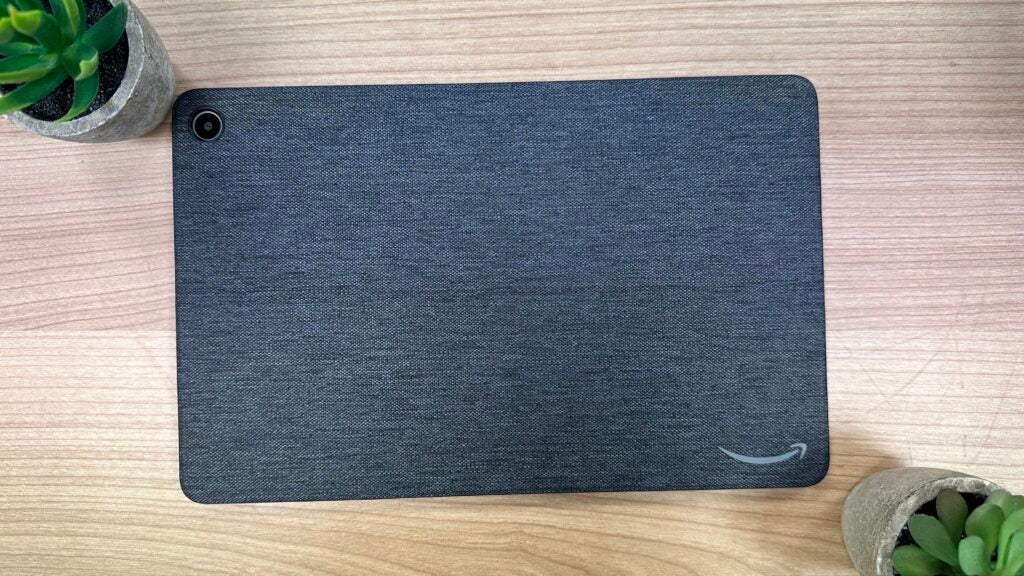
Don’t get me wrong, this won’t be competing with the iPad 10’s A14 Bionic chipset any time soon, but it handled most everyday tasks – switching between apps, scrolling through the web on the Silk browser, reading on the Kindle app and playing a quick game of Township – with ease. Even basic 3D games like Roblox run without much complaint, and it can handle even the most ad-laden websites.
This is borne out in benchmark testing with the Amazon Fire Max 11 besting other budget-focused tablets like the Lenovo Tab M10 Plus 3rd Gen, but it’s far behind established budget options like the almost two-year-old iPad 9.
Despite the lack of fancy audio options like Dolby Atmos, the Fire Max 11 generates enough volume to fill a room comfortably and is clear and crisp even at those top-end volumes. Bass performance leaves much to be desired, as with most tablets, but it’s serviceable for watching a movie on the tablet without reaching for Bluetooth headphones.
And yes, they have to be Bluetooth headphones, as the Fire Max 11 doesn’t sport a 3.5mm headphone jack like other cheap tablets.
I’d usually dedicate an entire section to camera performance, but the Fire Max 11’s offering is lacklustre, even for a tablet.
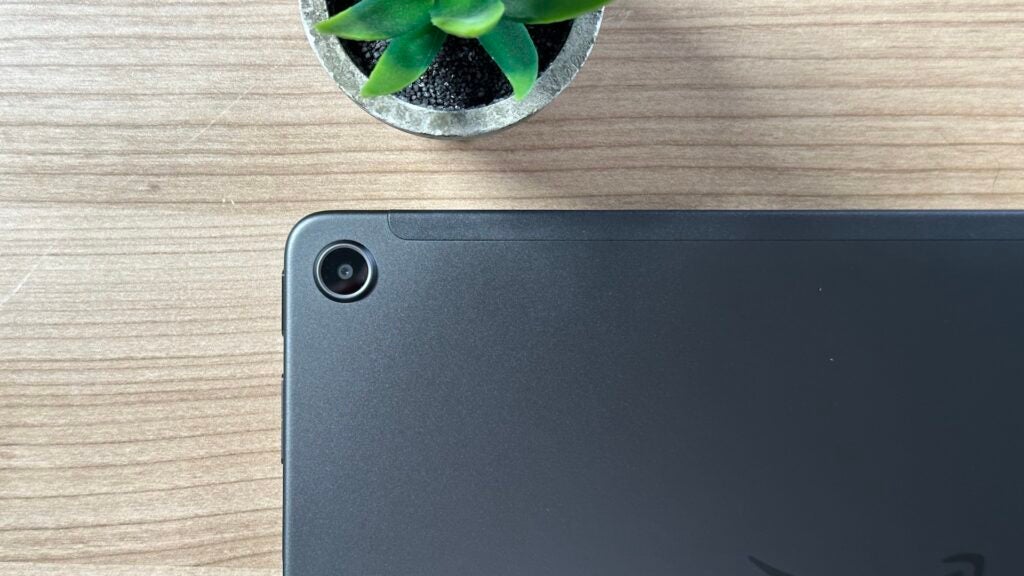
The combination of 8MP lenses – one on the front, one on the rear – is an improvement on the Fire HD 10’s 5MP and 2MP offering, but it’s still not close to what you’d get from the camera on the phone in your pocket. It’s detailed enough for video calling and the odd selfie, but you won’t be ditching your smartphone camera for this setup anytime soon.
Software
- Software will be a sticking point for many
- Not all Android apps are available
- Lack of productivity-focused apps
As is the case with every Fire tablet, software is the sticking point for many. It’s not a decidedly bad experience, but it’s very much an Amazon-first one with its own Appstore, browser and UI devoid of Google’s influence.
That means you won’t find Google services on the tablet despite it running on a modified version of Android 11. That means no YouTube, Gmail, Drive, Docs or Sheets, and although the store has plenty of apps, including Netflix, Disney+ and most social networking apps including Twitter, TikTok and Facebook, there are plenty of gaps in its collection – particularly when it comes to games.
Amazon’s game collection includes a few decent options, like Roblox, but it’s mainly packed with free-to-play games like Gardenscapes packed with microtransactions. You won’t find Call of Duty Mobile, Genshin Impact or anything like that here.
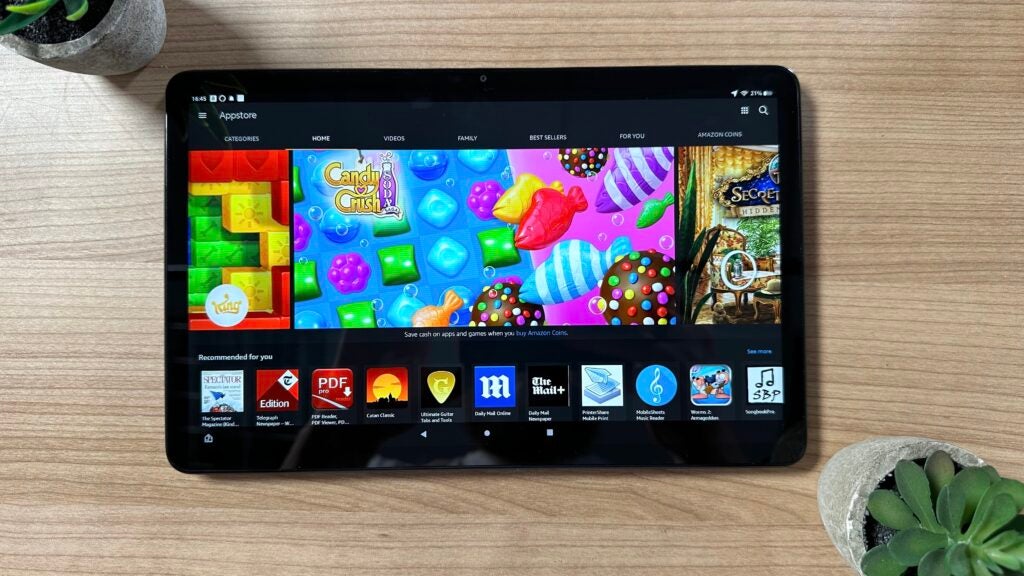
If you’re determined, you can sideload apps – it’s how I benchmarked the tablet, after all – but be warned that apps that rely on Google services (like Uber) won’t work on the tablet.
This also clashes with Amazon’s work-oriented pitch for the tablet. Most Android tablets struggle with the work-focused pitch because the Android OS lacks some of the ‘killer’ pro apps available for Apple’s iOS ecosystem. These range from video editing app LumaFusion Pro to the digital drawing app Procreate, and while the situation is slowly improving, there’s still a way to go.
That issue is even more prevalent on the Fire Max 11 with such a restricted offering on Amazon’s Appstore. While apps like Microsoft 365 are available on the tablet – complete with a three-month free trial – you won’t find apps for Google Docs and Sheets.
If you’re a Microsoft subscriber, that’s fine, but everyone else will be relegated to web apps. Having to use web-based apps where full-blown apps are available for iOS and Android devices isn’t ideal for either entertainment or productivity.
There’s also the lack of cloud storage apps available, with options like Dropbox and Google Drive unavailable on the tablet. This could cause serious issues if your work revolves around a specific app or platform that’s not available on the OS.
To Amazon’s credit, the company has updated the Files app to allow you to create spreadsheets and word documents without the need for a subscription, but the implementation leaves much to be desired.

Upon booting up the app, I was warned that WPS Office for Amazon was “built for an older version of Android and may not work properly” – hardly a great start. However, it got worse from there, with the word processing app failing to display correctly on the 11-inch display, cutting off the top menu and essentially making it unusable.
It seems that Amazon still has work to do if it wants the Fire Max 11 to be seen as a work-focused machine, even with its handy keyboard and stylus accessories.
Battery life
- 7500mAh battery
- Impressive standby times
- Super slow charging with included 9W brick
With a stripped-back version of Android, a fairly power-efficient (and not too power-hungry) chipset and a 7500mAh battery, the Amazon Fire Max 11 has the potential to last for quite a while. Amazon claims it’ll last around 14 hours on a charge – up two hours on the Fire HD 10 – and I’ve found that to be roughly on the money.
I used the tablet sporadically during a recent five-day trip to Amsterdam, including reading a book on the Kindle app at the airport and on the hour-long flight (in both directions), watching two movies on Netflix on one particularly rainy evening and playing a quick game of Townscapes to pass the time waiting for a cab. Reader, I got home with 30% battery left in the tank.
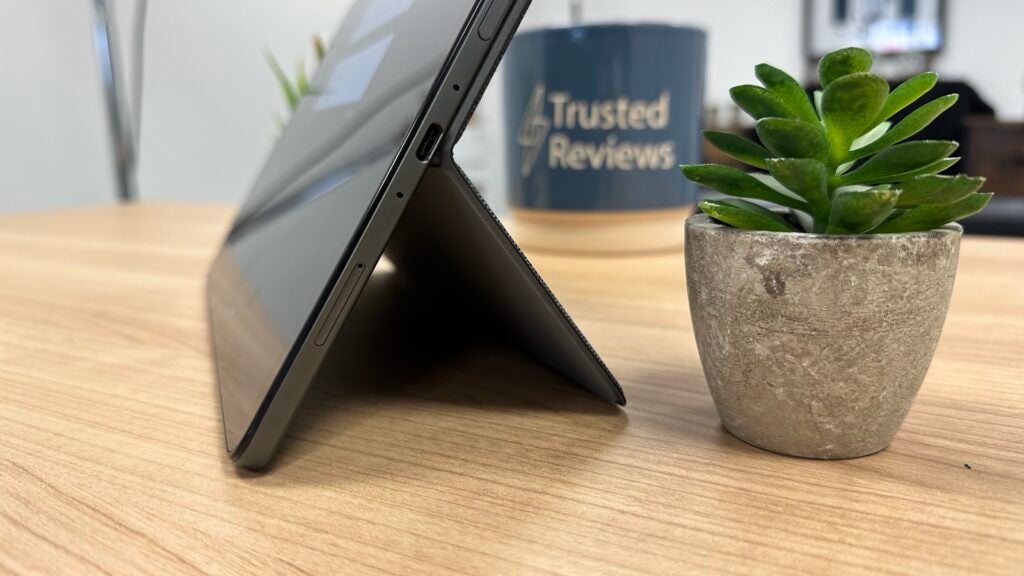
That speaks not only to the general battery life of the tablet but how well it does on standby, with the tablet reliably ready to go whenever I reach for it – even if it hasn’t been charged recently.
That’s a particularly strong point because, on the flip side, the Amazon Fire Max 11 is super slow to charge once it does finally die.
The tablet comes with a relatively weak 9W charging brick in the box that, in testing, took a whopping four hours to regain a full charge. The tablet does support up to 15W charging, so you could theoretically cut down on charge times (around 40 minutes less in testing), but you’ll have to invest in a separate charging brick to do so.
Latest deals
Should you buy it?
You should buy if you want a cheap tablet for streaming: The Amazon Fire Max 11’s 11-inch 2K display makes it ideal for streaming and gaming – as long as the app’s available on the Appstore.
You shouldn’t buy if you want a tablet for work: Even with official keyboard and stylus accessories, the lack of productivity-focused apps on the tablet means it’s less capable than most Android-based alternatives. Check out our best tablet list for more choices.
Final Thoughts
The Amazon Fire Max 11 isn’t quite the productivity-focused tablet that Amazon wanted it to be, even with pretty decent keyboard and stylus accessories, but that’s not down to hardware.
In fact, the 2K 11-inch display is one of the main reasons to opt for the tablet over the competition, with pin-sharp detail and great viewing angles. It’s not even down to a lack of processing power, with the unnamed octa-core processor easily beating other cheap Android tablets in CPU and GPU tests.
No, it’s down to the software offering. While the Android 11-based Fire UI is easy enough to use with most UK streaming apps available at the tap of a button, it lacks key productivity apps that’d make it ideal for work.
The fact that you can’t even get Google Docs, Google Sheets, Drive or anything else that relies on Google services is a bit of a red flag for anyone looking to get serious work done on a tablet. For that, you should pick up the OnePlus Pad or Apple’s iPad 10 – the latter is much more expensive but boasts a much more expansive app offering than any Android-based tablet.
If, however, you’re looking for a cheap tablet for streaming, scrolling through social media and a bit of light gaming and you can accept Amazon’s limited Appstore offering, the hardware is deliciously solid for the price.
How we test
Unlike other sites, we thoroughly test every product we review. We use industry-standard tests in order to compare features properly. We’ll always tell you what we find. We never, ever accept money to review a product. Tell us what you think – Send your emails to the Editor.
Used for a month before review
Reviewed alongside stylus and keyboard case
Benchmarked with industry-standard tools
FAQs
Yes, but it’s only 9W – you’ll have to buy your own 15W charger to take advantage of the fastest charging possible.
You can pretty easily, but any app that relies on Google services won’t work on the tablet.
Trusted Reviews test data
Geekbench 6 single core
Geekbench 6 multi core
Max brightness
1 hour video playback (Netflix, HDR)
30 minute gaming (light)
Time from 0-100% charge
Time from 0-50% charge
30-min recharge (included charger)
15-min recharge (included charger)
3D Mark – Wild Life
GFXBench – Aztec Ruins
GFXBench – Car Chase
Jargon buster
LCD
The type of display usually used on cheaper and mid-range devices. Lacks the punch on an OLED panel.
Verdict
The Amazon Fire Max 11 is a capable option with a solid display that beats most of the budget competition in benchmarks, but limited app availability means it’ll never be the productivity-focused tablet that Amazon envisions.
Pros
- Much more premium design than other Fire tablets
- Great all-day battery life
- Solid 11-inch 2K display
Cons
- Limited app availability
- Very slow to charge
-
Optional work-focused accessoriesDepsite not having the best selection of productivity-focused apps, the optional keyboard and stylus are great for word processing and doodling. -
Large display ideal for streamingThe 11-inch display of the Fire Max 11 is perfect for binging series’ on Netflix and iPlayer, with loud room-filling stereo speakers to boot. -
Smooth budget performanceDespite its budget focus, the Fire Max 11 can handle basic everyday tasks and even beats most of the budget competition in benchmark tests.
Introduction
The Amazon Fire Max 11 is the latest top-end Fire tablet from Amazon, boasting a bigger display, better performance and longer battery life than the Fire HD 10 Plus. It’s certainly a change from the cheap-as-chips Fire tablets Amazon usually makes, but can Amazon compete at the higher price point?
After all, the £249/$229 Amazon Fire Max 11 runs the same Fire OS as the rest of the Fire tablet collection – software based on Android 11, but utterly devoid of any Google apps or Google services, running Amazon equivalents instead. The App Store is pretty stocked with streaming apps, but it doesn’t have everything that you’d find on a regular Android tablet.
That makes Amazon’s pitch for the Fire Max 11 as a productivity device a hard one to swallow, even with a pretty capable keyboard and stylus accessories available at additional cost.
However, if you can get along with the app offering and Amazon branding, the Fire Max 11 is a solid budget tablet with performance besting most of the cheap competition, a solid 11-inch display, an aluminium frame and 14 hours of battery life.
Design and build
- A different look to other Fire tablets
- Looks a lot like an iPad
- Only available in grey
In a bid to separate itself from the cheaper tablets in Amazon’s Fire collection, the Amazon Fire Max 11 looks decidedly more premium. In fact, rather than looking like a Fire tablet, it looks more like one of Apple’s recent iPads – more specifically, the 10th-gen iPad.

Its aluminium body is squared off with flat edges, just like Apple’s option, but it doesn’t stop there. The bezels are also of a similar size to the iPad 10, the camera is embedded in the long side of the tablet for better landscape use and even the rear camera protrudes from the shell in the same way that Apple’s does.
There’s also a handful of pro-level accessories (I’ll get to those in a minute) and even a fingerprint scanner built into the power button.
That’s not necessarily bad considering Amazon’s tablet is cheaper than the £499/$449 iPad 10, but it’s not exactly an original look. It’s a bit of a shame that it’s only available in the rather ‘professional’ grey finish, too – I think a splash of colour could’ve helped it stand out from a sea of other budget grey tablets available on Amazon’s storefront.
It does differ from Apple’s iPad in a handful of ways, though. While storage caps out at 64 or 128GB, you have a microSD card slot to extend storage when required. There’s also the odd placement of buttons, with the volume and power buttons appearing alongside the USB-C port and microSD slot on the short right-hand side of the tablet (when viewed horizontally, that is).

It’s a placement that took quite a while to get used to, and rather annoyingly, it became awkward to hold when charging. I was either trying to avoid knocking the USB-C cable or accidentally hitting the power or volume keys.
There’s also a slightly less elegant POGO system for connecting accessories, with the exposed ports on the bottom edge of the tablet and gaps for accessories to snap into place. It’s not exactly the slickest approach, but you probably won’t notice it often.

Elsewhere, Amazon claims that the Fire Max 11 and its strengthened glass is three times more durable than the iPad 10 in its own drop tests. That’s not something I’m easily able to test, but it should bring peace of mind to those with clumsy kids nearby.
There’s no official IP rating, however, so probably best to keep it away from kitchen countertops and bathrooms.
Display
- Large 11-inch display
- 2000 x 1200 resolution
- Not quite bright enough for use outdoors
One of the main reasons to opt for the Amazon Fire Max 11 is the display. The 11-inch IPS LCD display may not boast the deep blacks and vivid colours of OLED panels, but that’s not something you’ll find at the price point. What is important is that with a 2K (2000 x 1200) resolution, the screen is pin-sharp and packed with detail.
It also offers excellent contrast with a wide viewing angle, making it possible for me and my partner to huddle together on the sofa and enjoy a movie without fiddling with the angle.
It also exceeds the iPad 10’s display in one key area; lamination. The Fire Max 11’s display is fully laminated, and while that might not sound like much, it means there’s no air gap between the front glass and the LCD panel beneath.

That means that, unlike the iPad, there isn’t a cheap hollow sound when you tap on the display. It feels robust, well-built and as noted earlier, it’s covered in an unnamed protective glass that should protect it from a drop or two.
If there’s any area where the Fire Max 11 could improve, it’d be brightness. Amazon’s claimed 420nits brightness is acceptable for indoor use, but it leaves much to be desired if you wander out to the garden on a particularly sunny day. It’s still just about usable, but you’ll likely be hunting for shaded areas.
The relatively low brightness means there’s no HDR support on offer either, though as with OLED tech, that’s something you’ll be hard-pressed to find at the £250/$250 price point.
Accessories
- Keyboard case is surprisingly capable
- Trackpad gestures come in handy
- Stylus is compatible with other tablets
As hinted at, the Amazon Fire Max 11 isn’t just another Fire tablet; it’s designed for work. Well, according to Amazon anyway – but I’ll get into the specifics a little later. In order to aid this lofty aim, the Fire Max 11 is compatible with work-focused accessories including a full keyboard case, complete with trackpad, and a stylus too.
The keyboard is actually pretty solid in everyday use with little key travel needed to activate each key, so much so that I actually wrote a large portion of this review on the tablet itself.

There’s a handy row of shortcut keys at the top like you’d find with a ‘proper’ laptop, and habitual Windows keyboard shortcuts also work, with the likes of Alt-Tab switching windows, CTRL + C copying text and more. The only downside is that it’s not backlit, which can be a bit of a downer when hammering away some text in a dark room.
The trackpad is also fine for everyday use, with gesture support allowing you to scroll with two fingers, pinch to zoom with two fingers and a three-finger swipe to switch apps. The only real oddity is the requirement to tap with two fingers to select text, which I couldn’t get used to during testing.

The optional stylus works in the way you’d expect, with pressure sensitivity and excellent palm rejection when taking notes on the Max’s 11-inch display, and it snaps into place on the side of the tablet when not in use just like an iPad. It’s also USI 2.0 supported, which means you can use it with other tablets like the Google Pixel Tablet, which doesn’t have an official stylus accessory.
It’s a handy optional extra for doodling and handwriting; it’s just a bit of a pain that it uses a standard AAAA battery that’ll need replacing every now and again.
Performance
- Unnamed octa-core processor
- 4GB of RAM
- Surprisingly decent budget performance
The Amazon Fire Max 11 continues the trend of Amazon using unnamed processors in its tablet range, claiming only that it’s an octa-core processor, and that’s paired with a measly 4GB of RAM and either 64 or 128GB of expandable storage depending on the variant you opt for.
Despite the rather underwhelming spec sheet, everyday performance on the Fire Max 11 is surprisingly solid for a budget tablet.

Don’t get me wrong, this won’t be competing with the iPad 10’s A14 Bionic chipset any time soon, but it handled most everyday tasks – switching between apps, scrolling through the web on the Silk browser, reading on the Kindle app and playing a quick game of Township – with ease. Even basic 3D games like Roblox run without much complaint, and it can handle even the most ad-laden websites.
This is borne out in benchmark testing with the Amazon Fire Max 11 besting other budget-focused tablets like the Lenovo Tab M10 Plus 3rd Gen, but it’s far behind established budget options like the almost two-year-old iPad 9.
Despite the lack of fancy audio options like Dolby Atmos, the Fire Max 11 generates enough volume to fill a room comfortably and is clear and crisp even at those top-end volumes. Bass performance leaves much to be desired, as with most tablets, but it’s serviceable for watching a movie on the tablet without reaching for Bluetooth headphones.
And yes, they have to be Bluetooth headphones, as the Fire Max 11 doesn’t sport a 3.5mm headphone jack like other cheap tablets.
I’d usually dedicate an entire section to camera performance, but the Fire Max 11’s offering is lacklustre, even for a tablet.

The combination of 8MP lenses – one on the front, one on the rear – is an improvement on the Fire HD 10’s 5MP and 2MP offering, but it’s still not close to what you’d get from the camera on the phone in your pocket. It’s detailed enough for video calling and the odd selfie, but you won’t be ditching your smartphone camera for this setup anytime soon.
Software
- Software will be a sticking point for many
- Not all Android apps are available
- Lack of productivity-focused apps
As is the case with every Fire tablet, software is the sticking point for many. It’s not a decidedly bad experience, but it’s very much an Amazon-first one with its own Appstore, browser and UI devoid of Google’s influence.
That means you won’t find Google services on the tablet despite it running on a modified version of Android 11. That means no YouTube, Gmail, Drive, Docs or Sheets, and although the store has plenty of apps, including Netflix, Disney+ and most social networking apps including Twitter, TikTok and Facebook, there are plenty of gaps in its collection – particularly when it comes to games.
Amazon’s game collection includes a few decent options, like Roblox, but it’s mainly packed with free-to-play games like Gardenscapes packed with microtransactions. You won’t find Call of Duty Mobile, Genshin Impact or anything like that here.

If you’re determined, you can sideload apps – it’s how I benchmarked the tablet, after all – but be warned that apps that rely on Google services (like Uber) won’t work on the tablet.
This also clashes with Amazon’s work-oriented pitch for the tablet. Most Android tablets struggle with the work-focused pitch because the Android OS lacks some of the ‘killer’ pro apps available for Apple’s iOS ecosystem. These range from video editing app LumaFusion Pro to the digital drawing app Procreate, and while the situation is slowly improving, there’s still a way to go.
That issue is even more prevalent on the Fire Max 11 with such a restricted offering on Amazon’s Appstore. While apps like Microsoft 365 are available on the tablet – complete with a three-month free trial – you won’t find apps for Google Docs and Sheets.
If you’re a Microsoft subscriber, that’s fine, but everyone else will be relegated to web apps. Having to use web-based apps where full-blown apps are available for iOS and Android devices isn’t ideal for either entertainment or productivity.
There’s also the lack of cloud storage apps available, with options like Dropbox and Google Drive unavailable on the tablet. This could cause serious issues if your work revolves around a specific app or platform that’s not available on the OS.
To Amazon’s credit, the company has updated the Files app to allow you to create spreadsheets and word documents without the need for a subscription, but the implementation leaves much to be desired.

Upon booting up the app, I was warned that WPS Office for Amazon was “built for an older version of Android and may not work properly” – hardly a great start. However, it got worse from there, with the word processing app failing to display correctly on the 11-inch display, cutting off the top menu and essentially making it unusable.
It seems that Amazon still has work to do if it wants the Fire Max 11 to be seen as a work-focused machine, even with its handy keyboard and stylus accessories.
Battery life
- 7500mAh battery
- Impressive standby times
- Super slow charging with included 9W brick
With a stripped-back version of Android, a fairly power-efficient (and not too power-hungry) chipset and a 7500mAh battery, the Amazon Fire Max 11 has the potential to last for quite a while. Amazon claims it’ll last around 14 hours on a charge – up two hours on the Fire HD 10 – and I’ve found that to be roughly on the money.
I used the tablet sporadically during a recent five-day trip to Amsterdam, including reading a book on the Kindle app at the airport and on the hour-long flight (in both directions), watching two movies on Netflix on one particularly rainy evening and playing a quick game of Townscapes to pass the time waiting for a cab. Reader, I got home with 30% battery left in the tank.

That speaks not only to the general battery life of the tablet but how well it does on standby, with the tablet reliably ready to go whenever I reach for it – even if it hasn’t been charged recently.
That’s a particularly strong point because, on the flip side, the Amazon Fire Max 11 is super slow to charge once it does finally die.
The tablet comes with a relatively weak 9W charging brick in the box that, in testing, took a whopping four hours to regain a full charge. The tablet does support up to 15W charging, so you could theoretically cut down on charge times (around 40 minutes less in testing), but you’ll have to invest in a separate charging brick to do so.
Latest deals
Should you buy it?
You should buy if you want a cheap tablet for streaming: The Amazon Fire Max 11’s 11-inch 2K display makes it ideal for streaming and gaming – as long as the app’s available on the Appstore.
You shouldn’t buy if you want a tablet for work: Even with official keyboard and stylus accessories, the lack of productivity-focused apps on the tablet means it’s less capable than most Android-based alternatives. Check out our best tablet list for more choices.
Final Thoughts
The Amazon Fire Max 11 isn’t quite the productivity-focused tablet that Amazon wanted it to be, even with pretty decent keyboard and stylus accessories, but that’s not down to hardware.
In fact, the 2K 11-inch display is one of the main reasons to opt for the tablet over the competition, with pin-sharp detail and great viewing angles. It’s not even down to a lack of processing power, with the unnamed octa-core processor easily beating other cheap Android tablets in CPU and GPU tests.
No, it’s down to the software offering. While the Android 11-based Fire UI is easy enough to use with most UK streaming apps available at the tap of a button, it lacks key productivity apps that’d make it ideal for work.
The fact that you can’t even get Google Docs, Google Sheets, Drive or anything else that relies on Google services is a bit of a red flag for anyone looking to get serious work done on a tablet. For that, you should pick up the OnePlus Pad or Apple’s iPad 10 – the latter is much more expensive but boasts a much more expansive app offering than any Android-based tablet.
If, however, you’re looking for a cheap tablet for streaming, scrolling through social media and a bit of light gaming and you can accept Amazon’s limited Appstore offering, the hardware is deliciously solid for the price.
How we test
Unlike other sites, we thoroughly test every product we review. We use industry-standard tests in order to compare features properly. We’ll always tell you what we find. We never, ever accept money to review a product. Tell us what you think – Send your emails to the Editor.
Used for a month before review
Reviewed alongside stylus and keyboard case
Benchmarked with industry-standard tools
FAQs
Yes, but it’s only 9W – you’ll have to buy your own 15W charger to take advantage of the fastest charging possible.
You can pretty easily, but any app that relies on Google services won’t work on the tablet.
Trusted Reviews test data
Geekbench 6 single core
Geekbench 6 multi core
Max brightness
1 hour video playback (Netflix, HDR)
30 minute gaming (light)
Time from 0-100% charge
Time from 0-50% charge
30-min recharge (included charger)
15-min recharge (included charger)
3D Mark – Wild Life
GFXBench – Aztec Ruins
GFXBench – Car Chase
Jargon buster
LCD
The type of display usually used on cheaper and mid-range devices. Lacks the punch on an OLED panel.







